If you’re somebody that does things like shooting firearms, or gets in contact with explosions. Then having something to protect your ears is a mandatory thing especially knowing that any hearing loss is permanent and nothing will bring it back. Combine this with the need of proper radio communication and situational awareness and you’ll find yourself in the product range of active hearing protection.

The 3M PELTOR ComTac XPI is such a product and in this "Before You Buy" we’ll do a review of it.
Before we dig into this subject if you want quality gear and like our work, please support us by buying over our store!
COMTAC XPI ≠ COMTAC XP = COMTAC III
To clarify, in this blog we will cover the ComTac XPI headset as well as the PTT available for it. One thing to notice is that the ComTac III in the USA is actually the ComTac XP from the EU but it has different wiring. This is the ComTac XPI which is an improved version of those models.
So that being said, let’s jump into the builds of these products.
1. COMTAC XPI BUILT
To start off with, what build options do you have for your headset?
COLOR
You can get it in a black or olive drab color.
BRIDGE, NECKBAND OR HELMET ADAPTERS?
Other features you can choose,
- A neck band which would apparently give problems when looking up.
- Helmet adapters, but do keep in mind that you then need a helmet to use it. Also these only come with ARC adapters so they only fit an ARC rail system. So no M-LOK system or Team Wendy system.
- A headband which is the one we chose and probably the most popular as well.
To us this is also the best option since you can wear it as it comes, underneath a helmet or you can get yourself third party adapters for a helmet. But then you do need to cut the leather bridge wrap to free the cable.

No need to worry, you can still go back to a headband version since there are replacement wraps available as well. If you would like some guidance on how to go from a headband setup to a helmet mounted setup, you can have a look at this link.
PTT CABLE & MIC
Another option is to get yourself a J11 cable to connect the headset with a PTT. This together with a detachable microphone, which can either be a dynamic or a flexible one. You do however also have a bone conducting microphone but it’s not so popular in usage.
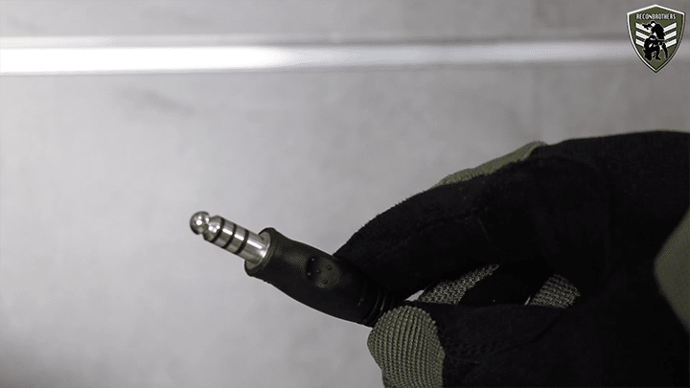
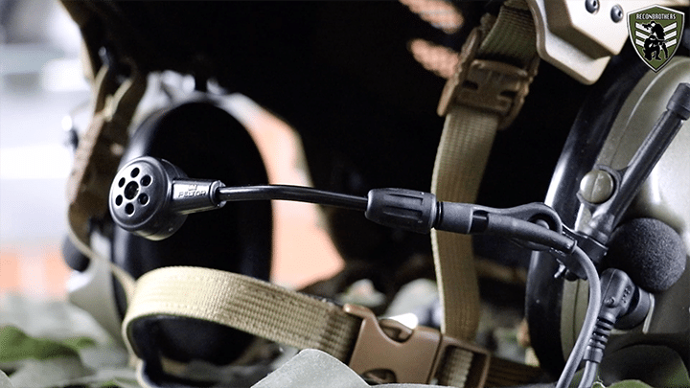
We ourselves chose to get a dynamic microphone and will mainly be covering this one today.
SINGLE OR DUAL COMM SETUP
At last, you can choose to get yourself a single or double comm setup, which allows you to work with either one or two radios while only using one headset.
2. HEADSET WITHOUT COMM FEATURES
If you have a headset without any comm features, don’t worry we have upgrade kits available at our store. And if you are a left hand dominant shooter, the microphone may be on the wrong side for you. But also here you can use one of our upgrade kits to make it suitable for you as well.
3. PTT BUILT
The push-to-talk for this headset, comes in a matte black color and the options are dependent on the radio system you use.

KENWOOD/BAOFENG
The first one is a Kenwood/Baofang PTT since they use the same pin. This one is called the FL 5035 and it’s made by PELTOR.
MOTOROLA & MIDLAND
The other two options we have are for Motorola and Midland and they are both made by Comhead. Since PELTOR doesn’t make them anymore.
The two PTTs made by Comhead are definitely not inferior to the one made by PELTOR. In some way they are actually even better, but we’re not going to dive too much into these since we don’t have any personal experience with them. But just so you know the options are there.
Now let’s have a look into the quality of these products.
4. COMTAC XPI QUALITY
STANDARDS
Starting off with the headset, it is tested to military standards so it can handle a whole array of extreme conditions. The standards are PPE directive 89/686/EEC, EMC directive 2004/108/EC, MIL-STD-810F and EMC-MIL-STD-461F.
For example, this means you can take the XPI on a swim for about an hour in fresh water and for about 30 minutes in salt water. Though, you can submerge with them it is not recommended to go too deep.
EAR PADS
Looking at the build of the headset, the outer part of the ear pad is made of a strong plastic.
The clips holding the headband and the ear pads together are made of plastic and can apparently break, if you’re not careful dismounting or mounting them.
A few tips here: If you want to dismount the clips turn them 90 degrees and pull them off. If you want to mount them you best use a wrench (again after turning them 90 degrees!).
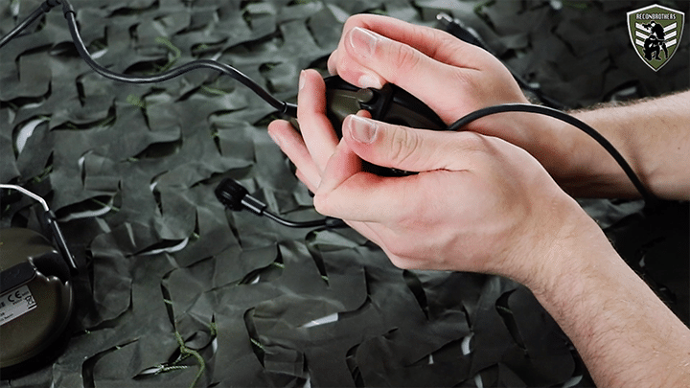
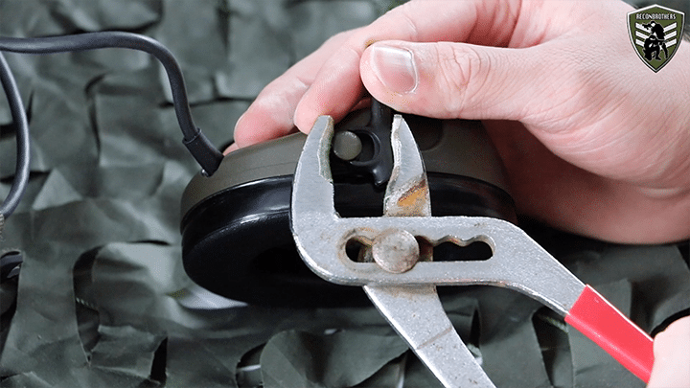
If you want to interchange between the headband and the helmet mounted version. It’s best to take out the metal bars instead of the clips.

BRIDGE
As for the bridge it is made out of a brass metal bridge, which is finished by a leather wrap.

MENU BUTTONS
On the bottom of the left ear pad you have two buttons for your menu which are easy to distinguish even with gloves on.
The menu buttons are easy to use. Simply push one of them a couple of seconds to turn system on or off. If you want to change the volume you can press the front button to amplify your sound and to reduce your sound you can push the back button.

BATTERY COMPARTMENTS
The battery compartments on both sides of the headset are easy accessible, made of plastic and also waterproof. Just so you know, the headset itself uses two AAA batteries.

EAR-CUSHIONS
The standard foam ear-cushions provide a good seal around the ears and feel comfortable around the head.

CABLES
At last the cables on the system are very solid built and all by all it feels like the headset can go through some pretty brutal stuff.
ADJUSTABILITY
The headset is quite adjustable which allows a fit for most people.
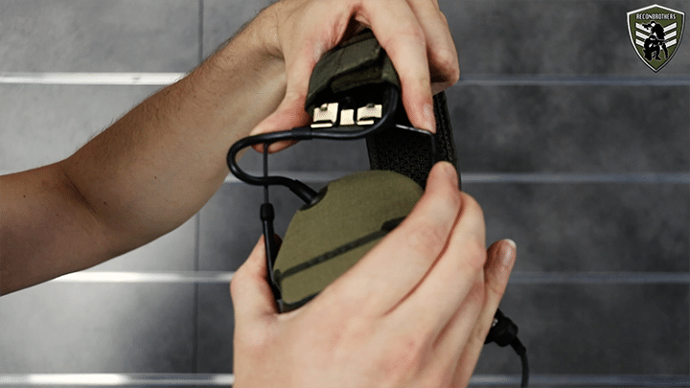
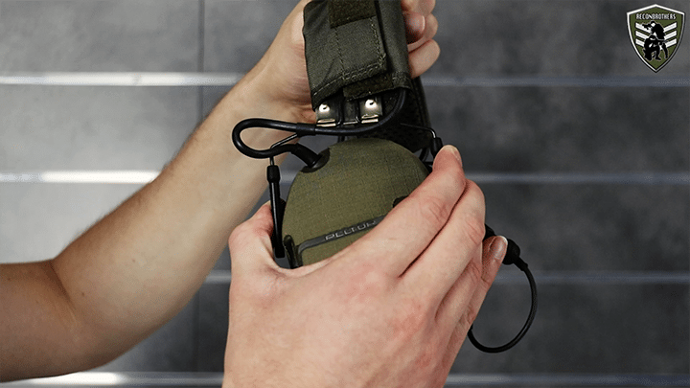

i. STORAGE
For easy storage and transport usage the headset can also be folded.
THE MICROPHONES
Let’s have a closer look at the microphones themselves. The dynamic microphone is length adjustable and uses hinges to change its positioning. Whereas the flexible microphone has a fixed length and is a bit easier in use.

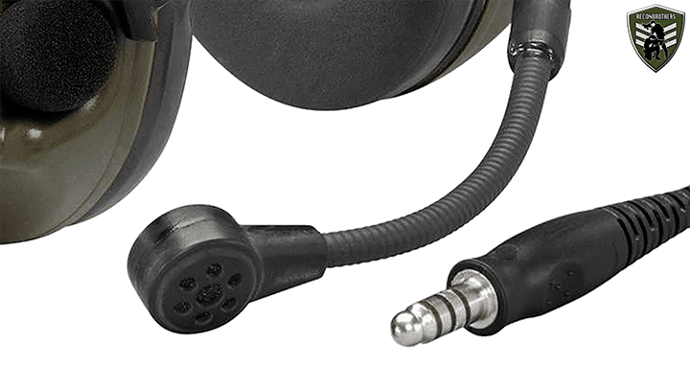
Both microphones are IP68 rated which means they are dust tight and waterproof for 30 minutes up to 3 m. They also feature an ultra noise canceling feature which is especially important in windy conditions.

J11 Cable
The J11 cable is also a tough build, and the jack is an absolute solid piece which is something entirely different than your usual 6 mm jacks. So it won’t break easily.
5. PTT QUALITY
STANDARDS
Going over to the PELTOR PTT it is also IP68 rated, meaning it is also dust tight and waterproof.

THE CASING
The PTT its casing is built of a tough plastic, and the cable is made the same way as the cables from the headset, so they can take on some rough conditions as well.

THE TRANSMISSION BUTTON
The PTT features a textured button which is easy to locate without the need to look, and is easy to reach with both hands.

THE CLAMP
It features a clamp on the back that can be rotated 360 degrees, and it can be removed by removing a single screw.
Now that we have covered all of this, let’s go over to the features of both products.
6. COMTAC XPI FEATURES
ACTIVE HEARING PROTECTION
The most important thing to know is that this headset has active hearing protection and not passive. The difference is that passive hearing protection muffles all surrounding or ambient sound, while active hearing protection selectively blocks hazardous sounds while still allowing you to hear at a normal or even an enhanced level.

This is due to the two external microphones that take in the sound. The system then decides what to do with it. Either block it or have it passed through the internal speakers at a normal or enhanced level.
The sound produced by the internal speakers can be increased or decreased in 4 levels with a maximum output of 82 decibels.
CONFIGURATION MENU
The configuration menu is fully voice guided and allows you to change some functions:
- RELEASE TIME
One of these functions is the release time that can either be slow or fast, whereas the slow one is used for indoor shots. Whereas the echo of the shots can create sound shocks.
- VOLUME BALANCE
Next up, is the volume balance between the ears which can be put on seven different settings. This is for example useful if you have hearing loss on your left ear, you can amplify the sound output of the left ear pad to regain your situational awareness.
- EQUALIZER & SILENCE MODE
Above an equalizer mode which are the 4 different sound levels we talked about earlier, this system also features a silent mode which shuts off the external microphones.
SNR
In total wearing the headset as it comes, gives you an SNR or signal-to-noise ratio of 28 decibels. If you require a higher reduction of decibels you can also wear earplugs underneath a headset which brings the total up to 39 decibels.
EARPLUG MODE
Remind that when it comes to volume every 3 decibels is a doubling of the sound energy. So 11 decibels is quite a lot. This is all good in terms of protection, but a problem that it usually brings along is that the output of the speakers is reduced too much as well. For this the system features an "ear plug mode", this enhances the speaker output by 6 decibels, so you can keep your communication and situational awareness with earplugs on.
HEADSET SPECS
The headset in total weighs 335 grams with batteries included. it can operate between -40 up to 55 degrees Celsius and it has an average runtime of 200 hours, but our supplier with much more experience says it can go even up to 300 hours.
7. COMTAC XPI IMPROVEMENTS COMPARED TO COMTAC XP
Besides these features the ComTac XPI has some improvements compared to its predecessor the ComTac XP (EU) or the ComTac III (USA).
These are:
- A better sealing of the battery compartment against moisture.
- A better sealing of the board against salt water.
- The removal of pressure points on the headband which are especially noticeable when wearing it underneath a helmet.
- It has an extensive voice guide menu.
- The volume of the connected radios can be changed and the microphone gain can be adjusted as well.
- With the ear plug modes, the volume of the connected radio is enhanced as well. They also added a silent mode where we talked about earlier which shuts down the external microphones.
Next up is the PTT.
8. PTT FEATURES
THE BUTTON
It has a button with a very positive feel that ensures you are transmitting even with thick gloves on.
J11 INSERT
The PTT has also been tested and approved for a minimum of 100,000 plugins with the J11 cable.
9. DEMONSTRATIONS
Now that we have covered all of this, let’s have a little demonstration of the headset. For this we recommend you to watch the video since this is an audiovisual demonstration. The demonstration itself starts at 9:48.
10. FINAL THOUGHTS
- The headset enhances your situational awareness allowing you to hear sounds you would normally not perceive and this while blocking explosions very well. This is obviously an advantage.
- It is very easy in use, reliable, tough and always offers a clear sound. We never had any issues with radio communications like calls not coming through or sending out.
- It is comfortable to wear for a couple of hours and would apparently be even more comfortable with gel cushions.
- The ComTac XPI is definitely a buy once cry once product since they are expensive but they will probably last you your lifetime.
If you are looking for 3M PELTOR products like the ComTac XPI or accessories you can find them on our store.
THANKS FOR READING!
Hopefully this blog was helpful for you. If you’re looking for these sort of products, accessories and much more cool stuff make sure to visit our webshop.
